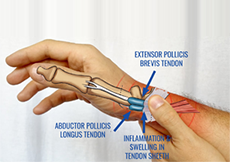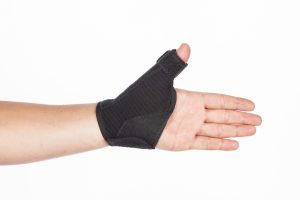Why do you have thumb pain?
DeQuervain’s Tendonitis or thumb pain? There could be several potential factors why you have thumb pain. For instance, arthritis, trigger thumb, or DeQuervain’s Tendonitis. Though, the location of pain and difficulties performing activities can determine what is causing your thumb pain. However, the most common reason for thumb pain could be DeQuervain’s Tendonitis. Let us know something more in detail whether you have DeQuervain’s Tendonitis.
What is DeQuervain’s Tendonitis and Thumb Pain?
It is an inflammatory condition, where the sheath around the tendon gets constricted. As a result, it affects the tendons of the thumb and thumb side of the wrist causing pain. Therefore, it gives the inability to use the hand and wrist to their total functional capacity.
What do the symptoms of DeQuervain’s Tendonitisfeel like?
Firstly, there is severe pain with thumb movements like gripping, lifting, twisting, and even a simple handshake.
Second, there might be swelling at the thumb aspect of the wrist.
Third, catching or snapping feeling with the movement of the thumb.
Lastly, limited thumb and wrist movement especially lifting the thumb up and in.
What are the causes?
There could be several reasons which cause you to DeQuervain’s Synovitis.
- Chronic repetitive strain to wrist and thumb in activities like typing, or doing hobbies like hammering, and gardening.
- It is also commonly seen in clients with Rheumatoid arthritis, Overuse, or repetitive strain to the wrist and the thumb.
- Pregnancy and post-partum are associated with breastfeeding and handling the baby.
- In women 40 and over.
What are the treatment options available?
DeQuervain’s Tendonitis responds well to treatment. The treatment options include Nonsteroidal anti-inflammatory drugs used for pain relief and reducing the inflammation of the tendons. Although, in chronic cases of pain and disability, cortical steroid injections are the most commonly used.
Also, resting the wrist in a splint and doing exercises like stretching and strengthening help relieve pain and gain functions back. At last, surgical release of the tendons. This is done in cases where they do not respond to conservative management.
How to choose the best treatment for yourself?
Anytime you are suffering from any of the symptoms listed above, always get yourself a detailed physiotherapy assessment. It could be done after your thumb surgery as well. However, they will identify the cause of your pain and tailor the best treatment strategy customized to your needs. Treatment for a conservative approach will focus on the points mentioned below,
- Education on the condition, what to expect throughout the rehab process, the normal healing period, and goals to achieve at various stages are provided.
- Advised on movements and activities to avoid to help in the healing process.
- Advise on using the correct splint or brace is given.
- Modalities such as ICE, heat, Ultrasound, and Laser and their effect on pain management are provided.
- Mobility exercises, which involve stretching and range of motion exercises are given to maintain the flexibility of the tendon.
- Hands-on technique to improve pain, and flexibility, and improve mobility of the joint is introduced at the appropriate time.
- Progressive Strengthening exercise which is client specific for the thumb and wrist is started once pain and mobility improve.
- Functional training and activity modification is taught to avoid recurrence.
Physiotherapy after surgical intervention: After surgery, the following are practiced.
- Methods and positions to control swelling or inflammation.
- Usage of splints.
- Exercises to improve ROM and flexibility in all joints in the hand, elbow, and shoulder.
- Exercises and activities to rebuild strength and function in the hand and upper extremities.
- Safe returns to previous activity levels are taught.
What will be the precautions to avoid the reoccurrence?
- First, avoid overuse of hands.
- Avoid excessive use of thumb and hand.
- Avoid forceful use of the hand.
- Lastly, taking frequent breaks from repetitive tasks.
To conclude, if you are suffering from the thumb, the wait is over. Our qualified team of Physiotherapists at PhysioNow will help you get better. Book your appointment today!






Leave a Reply